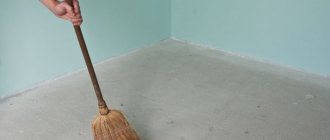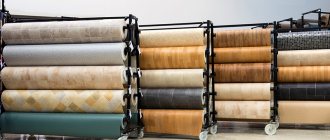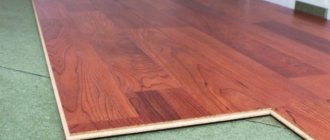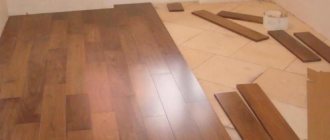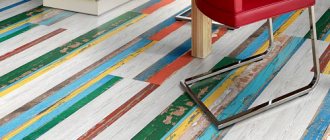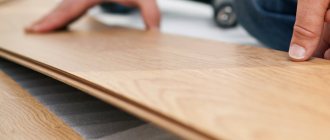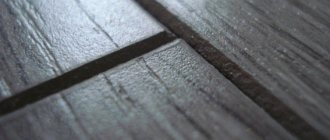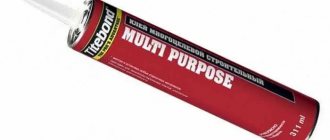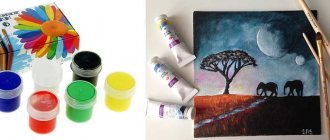The popularity of laminate flooring is growing every year. They began to actively lay it not only in living rooms, but also in the kitchen and bathroom. And if in the bathroom this type of flooring is still exotic, then in the room intended for cooking it is commonplace, replacing ceramic tiles and linoleum.
There are several reasons for dominance:
- the emergence of new types of lamellas that can withstand harsh operating conditions;
- beautiful appearance;
- the desire to make the same floors throughout the apartment;
- negative associations with linoleum left over from Soviet times;
- aggressive advertising of manufacturers and sellers of laminated panels.
There may be other, often individual reasons, which will certainly be given at the end of the work if readers share them.
The editors of the StroyGuru portal decided to delve into the problem more deeply and find out whether it is possible to lay laminate flooring in the kitchen of an apartment or house. During the analysis, we will find out where the real advantages of such a floor covering are, and where are the marketing moves of manufacturers, whether it is possible to find an alternative to laminate without losing quality and design, but saving money on materials and installation work.
Kitchen floor requirements
The kitchen is one of the rooms where, when choosing the type of flooring, the taste and preferences of the owner fade into the background. Here the priority indicators are:
- wear resistance - floors experience increased mechanical impact from the owners (studies by ergonomics experts show that residents spend about 40% of their time in the kitchen), as well as when moving stools and chairs from place to place;
- moisture resistance - the flooring is affected by two types of moisture: steam - in excess during cooking and water (more precisely, its splashes), which falls on the floor while working in the kitchen. Especially often the floor covering is wet in the work area;
The kitchen is in all its glory.
- easy care - stains from tea, coffee, wine, as well as grease should be easily washed off;
- durability - the service life of the floor covering is at least 25-30 years;
- safety - no one wants to get injured on a slippery floor;
- resistance to ultraviolet radiation and temperature changes.
And only after taking into account these criteria should you pay attention to the aesthetics of the material (appearance) and how it fits into the interior. If you ignore the above selection criteria, you can get a beautiful floor, which will soon become a headache for the owners.
Strength class
You can purchase material only if you know the required class of laminate for the kitchen. In the laminate class coding, the first digit indicates the load withstand, the second - the level of protection.
For example, class 22 encoding indicates a moisture-resistant material designed for rooms with average load. These can be living rooms in an apartment or a house. For the kitchen, such material can only be used if the apartment is inhabited by a maximum of 1-2 people.
More durable material class 32 can already be freely used in any kitchen; such a coating is designed for heavy traffic, but the level of protection remains in the “moisture resistant” category. After gluing the joints, the floor in the kitchen will be only slightly inferior to a full-fledged plastic laminate layer of class 33.
Laminate of classes 33 and 34 has characteristics that are in many ways inflated and excessive, as for the conditions of an ordinary apartment kitchen. Lamels up to 8 mm thick are intended for conditions in shops, cafes, and canteens, where people wear shoes with traces of moisture and street dust.
Such conditions are almost impossible to find in the kitchen. Unless this is the kitchen of a street cafe. For home apartments, even a corridor, even a kitchen, a waterproof laminate of class 32 will be enough. It is clear that purchasing class 34 flooring means that either half of the money was simply spent aimlessly, or the owners bought a floor that will be used by subsequent generations of the family.
The price of moisture-resistant laminate flooring depends on the brand and class. For example, a square meter from the German Egger, class 32, costs 1020-1250 rubles. A similar laminate from Taiwanese Build System costs 690 rubles per square. Flooring material from Egger, but already 33 classes costs almost 1,500 rubles. Vintage brands of coatings of the same class 32 from the Belgian Tower Floor are sold at 13 thousand rubles per square.
Is it possible to lay laminate flooring in the kitchen?
If we approach the problem purely formally, then yes, laminated panels can be installed in the kitchen. But their compliance with the above criteria will vary depending on the type of lamellas. This is best demonstrated by the pros and cons of laminate flooring in the kitchen.
Pros of the solution. Active promoters of laminate flooring in the kitchen give the following arguments:
- high strength of the floor - withstands mechanical loads well;
- long service life, which is difficult to agree with. Extreme operating conditions still take their toll. As a result, the manufacturer's stated warranty period is not met. Attempts to seek compensation from the companies that manufactured the slats are doomed to failure - the guarantee does not apply to floors in the kitchen and bathroom;
- good wear resistance - only applies to foot abrasion. Damage from falling sharp objects, animal claws, and furniture is common. After all, the protective film on the front side of the lamella is not hard enough and is easily scratched;
- simple care - what is common in other rooms of the apartment does not work in the kitchen - tea and coffee stains are difficult to remove;
- wide selection of designs: patterns, textures, colors and sizes. This is a top ten plus. Indeed, laminate can satisfy any consumer needs for any interior style. We must not forget that with the right color and size of the lamellas, you can visually change the dimensions of the room: length and width;
- relatively simple installation;
- can be placed on a “warm floor”;
- affordable price corresponding to the quality. And this is one of the myths of laminate flooring advocates in the kitchen. The statement about the best price-quality ratio does not stand up to criticism. The arguments are as follows:
- Cheap laminate from China will swell immediately after spilling moisture (water, juice, alcohol, tea, coffee). With intensive use (the kitchen is one such room), it wears out quickly and also releases harmful substances when heated.
- Average-priced laminate is good for residential premises, but not for the kitchen - it is afraid of water. All attempts to seal the joint between the lamellas with wax or silicone sealant are doomed to failure - over time, the grout joint becomes thinner and ceases to perform its intended functions. In addition, sealing is expensive.
- The laminate that manufacturers advertise as the best flooring option in the kitchen is more expensive than linoleum, tiles and some types of natural stone.
Conclusion: laminate in the kitchen is not the case when we can talk about an acceptable (affordable) price.
There are a couple more statements that do not correspond to the real state of affairs:
- absorbs noise coming from outside well - just the opposite: it amplifies sounds by resonating;
- retains heat - in fact, the thermal conductivity coefficient is high compared to linoleum and natural wood (only tiles and natural stone (marble, granite, etc.) are worse).
Manufacturers and sellers do not like to talk about shortcomings And they are significant:
- In the kitchen work area, only vinyl laminate can withstand - high humidity and grease do their job. But PVC laminate and classic slats are not the same thing;
- Any type of laminate contains formaldehyde resins, which when heated begin to release formaldehyde (HCHO). And the kitchen is famous for the fact that during cooking, both the temperature and humidity there fluctuate;
- the ability to amplify sounds (resonate) does not bring pleasure to both the neighbors below and the inhabitants of the apartment. Attempts to solve the problem with a thicker substrate lead to a more disastrous result - the locking joints quickly collapse;
- spilled grease and coffee are difficult to remove;
- smooth laminate is very slippery after wet cleaning, which manufacturers are silent about, but traumatologists know;
- Violation of installation technology can lead to deformation of the floor, followed by complete replacement of the floor covering.
Conclusion: the owner is a gentleman - he will arrange whatever he wants in the kitchen. But wisely, you need to look at alternative options, which we’ll talk about below.
In the meantime, for those who firmly believe in laminate in the kitchen, we’ll tell you how to choose it.
We define with pattern, color and texture
As mentioned above, one of the advantages of laminate is its wide design range, which allows you to choose the right laminate for any interior design style. Let's see what it is like - the opinion that laminate can only imitate wood is completely wrong.
It’s easy to choose the right coating for any design
Classic wood is indeed one of the most popular types. Modern technologies make it possible to reliably depict almost any wood - from light birch to the rich, deep color of oak. An appropriate texture, an interesting pattern - it is quite difficult to distinguish laminate from wood.
Classic wood looks very noble
Laminate flooring that imitates aged wood looks no less interesting. The boards are treated in a special way to achieve the effect of retro parquet. Cracks, abrasions and decorative chips look surprisingly cozy. This laminate is well suited for country, classic and chalet interiors.
Aged oak is an excellent choice for a chalet
Leather laminate looks very interesting. This crocodile or python skin flooring is an extraordinary solution for the kitchen, but it definitely deserves attention. However, keep in mind that such a coating looks very catchy, even pretentious. Therefore, we recommend using it carefully, making the rest of the interior as discreet as possible.
Laminate can imitate any leather
Laminated metal coating is another modern invention. It looks very unusual and is well suited for high-tech or loft. The floor can look very futuristic, or it can imitate a smooth metal coating - it all depends on your preferences.
An excellent solution for a loft
At first glance, laminate stone floors are indistinguishable from porcelain stoneware. However, they feel much more comfortable and warmer. In addition, the cost will pleasantly surprise you. However, there is one nuance here - it is very important to choose a high-quality coating, since if the print on the film is applied carelessly, the effect will be blurry.
Stone can be comfortable if it's laminate
The same statement is true for laminate that imitates tiles. If printed correctly, it will be almost impossible to distinguish it from real ceramic tiles.
It's hard to believe there aren't tiles on the floor
Designer laminate can be almost anything. Drawings, prints, mosaics, various interesting textures... Using this laminate you can create almost any interior to your taste.
All this is also laminate.
As for the texture, it is very diverse. In addition to the classic glossy and matte surface, several more types stand out.
Thus, laminate with the “Texture” texture has a slight relief. The protruding parts imitate real inlaid parquet, making the floor look expensive and elegant.
Texture creates a volume effect
The fine lines of "Relief" add dimension to your floor, creating interesting patterns and providing interesting surface relief. This flooring is well suited for classic interiors.
Embossed laminate imitates stacked parquet
“Natural surface” looks even more authentic. The board, which completely imitates the structure of wood, is coated with a thin varnish. Even upon closer inspection, it appears that your floor is made of natural wood planks.
Ideally conveys the structure of the board
Butterwood is a matte laminate that looks like well-sanded wood. Smooth lines, beautiful patterns and perfectly smooth texture.
The characteristic oily sheen gives this species its name.
A waxed surface looks like wood that has been waxed, as the name suggests. The soft shine provides an incredibly cozy and warm impression.
Country-style laminate also looks interesting - an imitation of natural boards, slightly sanded but retaining their texture. A stylish solution in a rustic style.
Scratches and stains look very elegant.
How to choose laminate for the kitchen
When deciding which laminate to choose for the kitchen, you need to focus on the characteristics of the lamellas. First of all this:
- moisture resistance. Difficult operating conditions of the floor covering: high humidity and sometimes spilled water require the purchase of a moisture-resistant laminate. The fact that the product resists moisture is indicated by markings on the packaging in the form of a tap, a drop of water, the inscription “Aqua” or a drawn umbrella;
- wear resistance. Here you need to be especially careful. In popular literature, concepts are constantly being replaced: the strength class is attributed to the level of wear resistance. This kind of incident also occurs among professional craftsmen and experts. Therefore, you need to focus not on icon 33 or 34 (indicates the strength class), but on the combination of the letters AC and the numbers 3 or 4 or the number of people on the floor on the pictogram (see photo). For an apartment as a whole, abrasion class AC3 is sufficient, for the kitchen you need AC4 - too many people go there. And one more thing: wear resistance is not identical to the concept of hardness. This means that laminate flooring can withstand shuffling feet just fine, but suffer scratches or dents from pets' claws or falling breakable objects;
Abrasion class designations.
- strength. The criterion shows what dynamic and static load the slats can withstand during operation. That is, how much weight one panel can withstand over a long time. Let us be clear: you should not believe the numbers printed on the packaging. Reliable data is available only from products of German and Belgian companies. Although here, not everything is clear. Thus, the best models of class 32 have a higher level of strength than laminate in the class 34 segment, but with a more affordable price. One thing can be said about the products of Russian and Chinese enterprises - it’s a pig in a poke: you can buy both a good laminate and one with low strength characteristics. If we get lucky. For the kitchen, class 34 seems to be the best option - because of the refrigerator;
- surface type. The smooth surface of the laminate becomes slippery after wet cleaning. Therefore, it is better to buy textured slats. This is not only safety, but also a beautiful design, most often a wood look.
The cost of 1 m2 of laminate and its durability also play an important role. Although you don’t have to choose too much based on price: class 34 laminate with a high degree of wear resistance is correspondingly expensive (price starts from 2,500 rubles/m2).
Let's sum it up
So, the best laminate for the kitchen is moisture-resistant, class 33, with a non-slip surface with a slight texture. There is a higher wear resistance class - 34. This laminate is stronger, but it also costs significantly more. In our opinion, there is no point in overpaying.
Most modern options have a sound-absorbing layer 1-2 mm thick. If you don’t have it, buy a backing.
Click locks allow you to lay floors with base differences of up to 3 mm per linear meter. After installation, it is recommended to treat the panel joints with a special impregnation.
Don’t buy no-name laminate – don’t be fooled by the bargain price. If you are limited in finances, choose inexpensive coverage from a well-known brand, for example, Praktik or Decormatch. And look at the content of harmful substances, formaldehyde. Choose laminate marked E0 or E1 - it is safe for health.
For those who take into account the characteristics of the material, the coating will last a long time and retain its original appearance for the next ten years.
Is there a difference between moisture-resistant and water-resistant laminate and which is better?
The kitchen needs a floor that is not afraid of moisture. Manufacturers offer moisture-resistant slats. But waterproof laminate is sold along with them. Are these synonyms for the same type of flooring or something else? Let's figure it out.
On the one hand, purely logically there should be no difference between the concepts. After all, they give the same characteristic to materials - resistance to moisture. But manufacturers put into them completely different flooring characteristics.
So, by moisture-resistant we mean an MDF-based laminate, covered on the bottom with a film that does not allow water to pass through, and on the sides with wax. This protection allows you to protect floor panels from direct contact with water for ten minutes. After some time, water still begins to enter the body of the laminate. Absorption occurs at a level of 6-8%. But this is enough for the castles to swell and begin to collapse.
Moisture resistant laminate.
Waterproof slats absorb no more than 2% of water, while remaining completely immersed in water for up to a day. But such flooring is made from polyvinyl chloride and has nothing in common, except appearance, with classic laminate. It also has a different name: vinyl laminate.
By and large, this is the same linoleum, only cut into strips similar in size to laminate. By the way, PVC slats and linoleum have practically the same technical and operational characteristics, pros and cons. The differences are in price and complexity of installation - laminate is more difficult to install.
Conclusion: moisture-resistant and water-resistant laminate are completely different types of flooring. For the kitchen, with its humidity, you still need a waterproof product. But, according to the editors of the StroyGuru website, waterproof laminate for the kitchen is not quite the right solution.
After all, it is no different from linoleum in terms of technical characteristics and clearly loses in terms of the price factor. The problem is in the psychology of immigrants from the Soviet Union. They remember that nondescript floor covering with the beautiful name linoleum. And the fact that it has become completely different, fashionable in Western countries, is not yet perceived on a subconscious level.
Tips for care and use
High-quality laminate can last you up to fifteen years. However, in order for the service life to correspond to the declared one, you need to follow a number of recommendations for caring for laminate flooring.
With proper care, laminate flooring will last you for many years.
Use our recommendations:
- It is best to give preference to dry cleaning - sweeping with a broom, cleaning with a vacuum cleaner. This will prevent the laminate from coming into contact with moisture, which means the coating will retain its structure longer.
- On the other hand, dry cleaning in the kitchen alone is unlikely to be enough. You will most likely have to clean your floor regularly. To do this, use a soft mop or cloth. It is very important to wring it out well - the fabric should not be wet, but slightly damp. After washing, it is advisable to wipe the floor dry with a dry cloth.
- Use mild detergents. Soap solution, special floor cleaner, and dishwashing detergent are ideal. Avoid using cleaning products with abrasive particles - they can scratch the protective coating of the laminate. In addition, you should not use aggressive chemicals - this way you risk ruining the color and design of your floor.
- When a stain appears, it should be removed immediately, because in the future the dirt can become embedded in the material, after which it will be very difficult to remove it from the surface. For stagnant stains that cannot be removed with conventional means, you can use an acetone solution: apply it to the stain for a few minutes, remembering to then remove the solvent itself and the dirt.
- Have you spilled water or other liquid? Immediately pick it up with a cloth and wipe dry. Due to prolonged contact with liquid, the laminate may swell, especially at the joints.
- Do you have furniture with sharp legs, such as metal? Consider a protective foot cover. It will prevent the coating from scratches.
- If you want to renew the finish, you can use a special polish or cover the floor with a thin layer of varnish. You should not use wax or mastic: firstly, the coating will become slippery and you risk injury. Secondly, such polishes spoil the structure of the laminate, making it less resistant to damage.
- You can paint over shallow scratches with a wax pencil. Is the damage more serious than you would like? Use acrylic putty to disguise the chip. Please note that it dries for almost a day - the treated area must be handled carefully.
- Scratches should be treated immediately after they appear. A damaged floor structure is an excellent way for moisture to penetrate, which can cause the scratched board to become deformed.
As you can see, caring for laminate flooring is not particularly difficult. The main thing is to follow our advice.
Is it possible to make moisture resistant from ordinary laminate?
Apartment owners can, in order to save money, use ordinary slats to make a moisture-resistant laminate for the kitchen. This effect is achieved in several ways:
- cover the flooring with polyurethane varnish;
- treat the locks and bottom of each panel with polyurethane varnish or wax before installation;
- seal the seams with familiar silicone sealant;
- protect the locks from moisture by using wax grouts on the already laid laminate.
Such recommendations can be found literally on every corner: from manufacturers and sellers (well, of course, this is their bread that you want to eat with butter), professional builders (everything is also clear), numerous authors on various sites. To what extent the recommendations are correct (let’s be diplomatic and not use harsher statements), let’s find out.
1. Coating the floor with polyurethane varnish. There is no need to explain that the laminate is laid on a substrate. There is no other way. If there is a substrate, then there is vertical vibration of the lamellas under the weight of an adult when walking on the floor.
They are completely invisible to human eyes and legs. But the varnish layer reacts immediately to a deflection of one panel relative to another by only 0.5 mm - it loses its integrity. After a few months of use there will be no trace left of the protection. In addition, the varnish quickly wears off when walking and does not tolerate moving furniture - scratches immediately remain.
2. Treating the lock joints and the bottom of the panels with wax. Proponents of this method explain their proposal by the high porosity of the panel body. Firstly, this is not true - MDF, on the contrary, has a dense structure, and secondly, during operation, the locks of the laminate rub against each other, removing all types of protection. As a result, after a year or two, there will be no trace left of moisture resistance.
3. Silicone sealant. The elasticity of silicone allows you to maintain the integrity of the rubbed seam during vertical vibrations of the panels for a long time. But there is another problem: in work areas, the sealant is wiped off with feet within 4-5 months. Non-believer Thomas can look at the results of using a tiled floor, where epoxy grout, the most resistant, changes color and becomes gray in places with the greatest concentration of people.
This is not the result of exposure to UV rays, but the replacement of the epoxy layer with simple dust - when walking, the sealant clings to the sole with tiny particles. Dust settles in its place. As a result, the seams become depressurized. With silicone it’s even easier: it doesn’t have such strength.
4. Wax grouts. There's a lot of interesting stuff here. Not only does the cost of the floor increase (wax grouts are expensive - more than 25 rubles / m2), but the validity period is only a few months. Many will object: what is 25 rubles? even for families with below average income. But this is several times a year and for at least 10 years. The result is huge costs comparable to the cost of a new floor. So, is the game worth the candle?
Popular laminate manufacturers
Products from well-known companies are in demand among consumers:
- Pergo;
- Berry Alloc;
- Kaindl;
https://youtu.be/gX7Dy-W2q30
- Kronotex;
- Balterio;
- CLASSEN;
- Tarkett;
- Quick-Step.
So maybe not laminate, but tiles
The forums are full of questions: which is better, laminate or tiles in the kitchen. But the question needs to be posed more broadly: what is the alternative to laminate in the kitchen. If you only consider the laminate/tile pair, then tiles have many advantages:
- does not scratch;
- not afraid of water and fat;
- easy to clean with any detergent;
- costs less than moisture-resistant slats;
- serves for a long time.
But it has one drawback: due to the hardness of the floor, the musculoskeletal system of a person who spends a lot of time in the kitchen - typical for mothers in large families - is heavily strained. This has already been discussed in one of the comments on our website.
Therefore, it is worth thinking about linoleum and quartz-vinyl laminate. They are affordable for home owners, are not afraid of moisture, look impressive, and are superior in quality to laminate. In some cases, even a specialist cannot visually distinguish linoleum from laminate.
What to prefer if you plan to have a heated floor
If we abstract from other performance characteristics of laminate and ceramic tiles, then any of the listed coatings can be placed on a “warm floor,” although with different effects.
Is it possible to turn ordinary laminate into waterproof?
To create special water resistance properties, you can do it quite simply and cheaply. To do this, during installation you will need to lay the floor covering without using a backing. Typically, an adhesive mass is used for this, and then the top is treated with polyurethane varnish. Such a product will have excellent technical characteristics, and due to its high porosity it will provide resistance to liquids. Nevertheless, experts recommend waterproofing the base, which will eliminate the problem of water accumulation in the lamellas.
As for the disadvantages of such a life hack, the low resistance to high loads stands out. In conditions of high traffic, faster abrasion is observed, and, consequently, a decrease in service life. Usually the difference in operational applicability is almost 2 times. It is imperative that the floor covering be restored and repaired during use.
polyurethane varnish
To turn a regular laminate into a waterproof one, glue and polyurethane varnish are used - they are used to treat the coating
Is it possible to combine tiles and laminate?
Practice shows that a combined tile and laminate floor in the kitchen is the most effective way to solve the problem of flooring in the busiest room of the apartment. In this case, the combination is always carried out according to the same scheme: the work area is tiles, the dining area is wear-resistant laminate.
This approach eliminates several problems:
- a safe sanitary area appears with a durable coating of tiles or porcelain stoneware, which is almost 2 times more wear-resistant than the best laminate;
- water leakage under the kitchen unit can be easily eliminated without consequences for the floor;
- the furniture and refrigerator sit on the tile like a glove - there is no play, like on laminate;
- There was an opportunity to lay ordinary (non-moisture resistant) laminate in another part of the kitchen, where there is no grease and water.
But such a floor covering has other design-related problems: how to choose the right laminate for the tiles in the kitchen so that the floor is a single whole and does not create the impression of an ever-drawn-out renovation.
How to calculate quantity
The number of slats can be calculated only if you know the exact area of the room, width, and length of the working surface of the slats.
You can make a drawing on paper, use it to calculate the number of parts required to lay one square meter, then multiply the result by the footage of the home.
How to arrange a transition
The combination of tiles and laminate requires solving the issue of transition from one type of floor to another. There are several ways to join floor coverings:
- using a cork gasket;
Cork gasket.
- covering the seam with an aluminum decorative strip used to fix linoleum near the walls;
Aluminum strip.
- sealing the seam with sealant;
- arranging a podium along the joint line;
- masking the connection of two types of flooring with a PVC overlay.
Vinyl overlay.
In this case, the connecting line should pass at a distance of one and a half steps of the cook (usually the mistress of the house) from the tabletop. This is a guarantee that when taking a step back, the cook will not trip over the threshold. The podium is set up in the same way. The tiles are 2-3 cm higher. Rarely, but it happens the other way around when the laminate is higher.
Attention: advice from the site staff - the seam line should not cross the main direction of movement of residents. Kitchen visitors should move parallel to the joint. In this case, the risk of tripping is zero.
Combination options
Both types of floors, regardless of the space occupied, color and texture, actively influence the perception of the interior. But there is a nuance: the floor covering adjacent to the furniture always more intensely shades and enhances the decorative effect of the furniture in the interior. Therefore, you need to pay special attention to the tiles and select them in contrast to the laminate or in similar color tones.
So, beige tile color goes well with brown or terracotta laminate. It does not draw attention to itself, but visually neutralizes high humidity and temperature in the kitchen, creates a calm, relaxing atmosphere, and has a calming effect on the nervous system.
The method of sealing seams should show kitchen visitors the floor as a single whole, although assembled from two different materials in color and texture.
Pros - cons
The main advantage of laminate is that it replicates expensive materials well, not being much inferior to them in terms of wear resistance and practicality, while being cheaper.
An affordable price does not deprive the coating of its functionality - a high-quality laminated floor can be laid in the kitchen, since the coating is easy to clean, does not lose color under ultraviolet rays, and is not afraid of stains, impacts, cracks or scratches. Really high-quality material will be resistant to abrasion.
Why is it better than other floor coverings - tiles, linoleum, self-leveling flooring, parquet and solid boards?
- It is warmer than tiles and less noisy;
- Unlike parquet and solid wood, marks from stiletto heels do not remain on laminate;
- There are no dents left on the laminate from heavy kitchen furniture, which is typical for linoleum;
- You can easily lay it with your own hands and without a partner - unlike a self-leveling floor, for example;
- Laminate is practically the most affordable type of floor finishing.
However, if in the bedroom and living room laminate can be called an ideal coating in all respects, then in the specific conditions of the kitchen it still has some disadvantages.
- Some types of laminate really cannot (or can, but with caution) be placed in the kitchen, since they cannot withstand high humidity, temperature fluctuations, or spilled coloring liquids such as wine or beet juice, and can become deformed when dropped by heavy and sharp objects. We will tell you how to choose laminate for the kitchen below;
- The disadvantages of laminate flooring include a rather loud sound, which forms a coating when steps are taken or objects fall. However, this drawback is more a consequence of incorrect installation than a problem with the material itself. The “defect” is eliminated using a special sound-absorbing substrate;
- There is an opinion that laminated coating is not environmentally friendly enough. But manufacturers with a well-deserved reputation in the market refute this misconception by conducting serious tests for the toxic safety of their products. Such tests are confirmed by a hygienic certificate that accompanies each batch of material;
- Artificiality - no matter how reliably it imitates original materials, it still remains a copy and, to one degree or another, is inferior to them in aesthetic and performance qualities.
Laminate laying technology
Laminate flooring is laid on both concrete floors and rough wooden floors. All work is performed in the following sequence:
- the base is being repaired;
- hydro- and thermal insulation work is being carried out;
- the screed is poured;
- A plastic film is laid over the screed;
- the substrate is laid;
- laminate is installed.
Laying laminate flooring is discussed in detail in the works: “How to lay laminate flooring on a concrete floor”, “How to properly lay laminate flooring on a wooden floor”.
Lamella structure
There are 2 types of waterproof laminate on the modern market.
- A matrix that is made using polymers.
- Composite laminate, which is created using pressed cellulose. Various polyurethane and polyethylene compounds are added to the latter.
The cheapest and most affordable laminate is considered to be the one made from polymer-wood composite materials. A similar line is created according to standards that allow it to resist liquid for 5 hours. Please note that such a coating has good thermal insulation. Among the disadvantages, one can point out the short matrix, which causes greater fragility during installation. To carry out installation, it is imperative to create a flat floor, as well as to ensure careful connection of the locks. Please note that such a product, in terms of technical parameters, is often compared to a decking board.
A cheaper waterproof laminate is considered to be one made using polymer-wood composite materials.
As for the polymer waterproof laminate, it is produced on the basis of polyvinyl chloride. Its shape is set using high pressure through special molds. Please note that the intermediate layer is made from polypropylene or polyethylene. The upper part is made using paper, PVC or other film. Products of this type have impressive strength. You can check by creating physical activity or changing temperature conditions.
Important! On such a floor you can not only use aggressive detergents, but also completely fill it with water for 20 hours.
moisture resistant laminate
Compatibility with heated floors
Warm floors go well with laminate, provided that a number of conditions are met.
- Specialized flooring cannot be laid directly on electric floor heating systems. This is due to uneven heating of the surface, which leads to the creation of cracks. It is better to use film or water systems.
- The temperature should be increased gradually. It is extremely important not to allow the temperature to rise above 28 degrees. Be sure to install a rheostat and specialized sensors to regulate the temperature.
- During the heating season, it is advisable to use additional devices that will humidify the air. In the kitchen, the laminate should not dry out, so the humidity level should be at 50%.
Laminate can be combined with underfloor heating systems, but the temperature cannot be increased too much - it can become deformed
Manufacturers and price tag
Regular inexpensive laminate class 33 is sold in online stores at a price of 450 rubles per square meter. If you purchase it with a moisture-resistant finish and for heated floors, then the price tag is in the range of 700-1500 rubles, depending on the brand. Popular European materials are supplied to the regional market at a price of 1000-2500 rubles per square meter. The following collections are ideal for the kitchen:
- Tarkett (Woodstock Family, Estetica, Robinson);
- Kronotex (Mammut and Amazone);
- Imperial (Lumia, Lux and Exclusive);
- Pergo (Sensation);
- Ritter (Charlemagne, Nefertiti);
- Kronospan (De Facto, Symbio, Salzburg).
Typically, the cost per square meter of laminate varies from 700 to 2500 rubles, depending on the class and manufacturer
Tools and material for preparatory work
- Tools
- Screwdriver or screwdriver.
- Construction spatula, for applying mastic or putty.
- Level for measuring slope.
- Chisel, for removing individual irregularities.
- Knife.
- Assembly crowbar for dismantling individual elements.
- Grinding machine or grater.
- Hacksaw or electric jigsaw.
New coating should only be laid on a clean and dry surface. Therefore, you will need a container for garbage, a dustpan, a brush or a mop; if there is little garbage and it is small, then you can collect the garbage with a vacuum cleaner.
- Material
- Putty, for filling unevenness.
- Universal glue.
- Plywood to level the floor.
- Self-tapping screws must be selected in such a way that, after screwing in, they go at least two centimeters into the base under the old floor. The heads of screws and nails must be recessed.
- Sanding wheels and sandpaper.
After completing the preparatory work, you can begin laying the new laminate. You will need additional tools. You also need to prepare enough material.
- Additional tools needed
- Roulette.
- Rubber mallet.
- Construction angle 90°.
- Pencil.
- Wooden blocks to set the required distance from the wall.
- Clamp for mounting the last strip.
The kitchen dictates the conditions
Laminate on the wall in the kitchen interior can look quite impressive. However, visual perception is far from the main criterion here. A kitchen in an apartment is a special kind of room. This is where the cooking takes place.
For this purpose, water is supplied and various heating devices are installed. The conditions here are quite harsh. During cooking, the room temperature can rise to 30-40 degrees. The walls are exposed to hot steam, often saturated with drops of oil. When ventilating, condensation may settle on vertical surfaces.
At the same time, several zones are distinguished in the kitchen. The most difficult area is in the area of the sink, cutting tables and stove - this is the so-called kitchen apron area.
The rest of the wall surface is in more comfortable conditions. But it is also affected by high humidity.
Thus, the finishing material for walls in the kitchen should have the following qualities:
- withstand elevated temperatures up to 40 degrees;
- do not deteriorate from high humidity;
- have low thermal conductivity to prevent intense condensation formation.
Therefore, finishing a kitchen wall with laminate is only advisable if the coating meets these requirements.
Kitchen completely finished with laminate - beautiful, but impractical
Installation work under heated floors
As noted earlier, laminate can be used in conjunction with heated floors. To do this, you need to implement the following tips.
- Electrical systems must not be used. Since the film heats up as quickly and unevenly as possible, the floor covering dries out and undergoes deformation. The best option is water or infrared TP.
- The product does not tolerate sudden temperature changes. That is why it is necessary to smoothly regulate the temperature. Special sensors and a rheostat should be used to regulate the heating procedure.
Laminate does not “like” temperature changes - adjust the temperature smoothly
- Try not to exceed the temperature above 28 degrees. Otherwise, fragility and brittleness increases.
- During operation, it is advisable to acquire air humidifiers. It is important to maintain humidity at least 50 percent. Otherwise, cracks will appear on the floor.
If you put these tips into practice, you will be using laminate flooring for many years.
infrared film
Design Features
When working on the style, it is important to assess the size of the board. Typically, rectangular variations are used for the kitchen, the length of which is 1200 mm. The width should not exceed 200 mm. It is important to note that there are various variations on the market, with a wide variety of elements in width and length.
The second position is associated with the presence or absence of a chamfer. If the product is sharpened to look like wood, then the latter has special grooves. They set a non-standard effect and allow you to specify a non-standard design.
Important! When choosing, pay attention to the markings 2V and 4V, which indicate the number of sides with a chamfer.
It is important to pay attention to the design of the laminate - it is often designed to look like wood, which looks quite beautiful
As for design, wood-look variations are currently popular. That is why solutions called “oak”, “ash” and so on are presented on the market. Each option has a nuance. For example, oak has more than 50 of them. The pattern on the planks may differ. The more expensive the material, the more varied the pattern will be presented. Products imitated with natural stone deserve special consideration, as they allow for heat retention and a non-standard design.
How can you prepare an old surface without completely dismantling it?
- Walk over the entire surface, pressing on it in a checkerboard pattern, every fifty centimeters. In places where there is a loose fit, you need to tighten the screws that should go into the base of the floor.
- Level out defects on individual panels of old laminate. Large chips and cracks must first be repaired with mastic or a special putty.
- Level off excess slope. To do this, you can lay thin sheets of plywood and fix them with glue or nails. Individual tubercles and uneven joints must be sanded. This can be done manually with sandpaper, or you can also use a grinding machine.
- Heavily damaged panels should be removed. Their places can be filled with plywood or putty.
